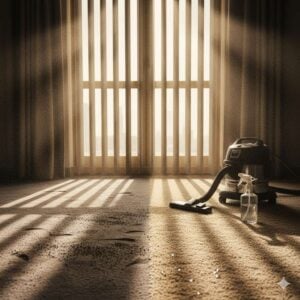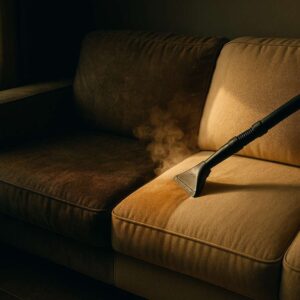Moving or storing furniture in the UAE can be tricky, especially with the heat, humidity, and dust that easily damage delicate materials. Furniture wrapping is one of the most effective ways to protect your belongings, whether you’re relocating, renovating, or simply keeping items in storage. Many people choose to do it themselves to save costs, and with the right approach, it can be both affordable and efficient. In this article, we’ll guide you through seven practical DIY steps for furniture wrapping, along with a realistic cost estimation. We’ll also share how professional help from Bio-On Cleaning Services can make the process faster and safer when you need guaranteed protection for valuable items.
Table of Contents
ToggleWhy Furniture Wrapping Matters
Furniture is often one of the biggest investments in a home. From leather sofas to wooden cabinets and glass tables, each material reacts differently to moisture, sunlight, and dust. In Dubai and other Emirates, the hot climate and frequent sand exposure make unprotected furniture deteriorate faster. Wrapping keeps items safe from scratches, fading, and contamination during moves or storage. Whether you’re transporting items across the city or leaving them in a warehouse, proper wrapping prevents costly damage and keeps your furniture looking new.
Step 1: Gather Your Materials
Before you start wrapping, prepare all the necessary tools and materials. For most furniture types, you’ll need stretch film (plastic wrap), bubble wrap, packing tape, scissors, soft cloths, and cardboard sheets. For fragile or luxury furniture, corner protectors and foam padding are essential. These materials are widely available in hardware or moving supply stores across the UAE, and buying in bulk often reduces costs. Always choose high-quality wraps that are tear-resistant, especially if the furniture will be stored for long periods.
Step 2: Clean the Furniture Thoroughly
Wrapping dirty furniture traps dust, grease, and moisture that can cause stains or unpleasant odors later. Start by dusting surfaces with a dry cloth, then wipe them with a damp microfiber cloth. For wooden furniture, use a mild cleaner suitable for wood finishes. Upholstered or leather furniture should be vacuumed and cleaned with fabric-safe or leather-safe solutions. Let every piece dry completely before wrapping to avoid mold or mildew growth, especially in humid conditions.
Step 3: Disassemble If Possible
Many furniture pieces, such as tables, beds, or shelves, can be disassembled into smaller parts. Doing so not only makes wrapping easier but also prevents stress on joints and fragile connections. Remove detachable legs, drawers, and glass panels, then wrap each part separately. Keep screws, bolts, and small hardware pieces in labeled plastic bags taped to the corresponding furniture piece. This simple step saves a lot of confusion during reassembly.
Step 4: Wrap with Soft Protection First
Before using plastic or bubble wrap, start with a soft layer of protection. Old bed sheets, blankets, or cloth padding prevent scratches on delicate finishes. This base layer also absorbs moisture and helps cushion the furniture. Wrap the item completely, ensuring no part of the surface is left exposed. Secure the soft layer with light packing tape or rubber bands to hold it in place without damaging the surface.
Step 5: Apply Bubble Wrap or Stretch Film
Once the soft layer is in place, apply a second layer of bubble wrap or stretch film. For fragile items like glass tables or mirrors, use bubble wrap with large bubbles for better shock absorption. For heavy items like cabinets or dressers, stretch film provides tight, secure coverage that keeps drawers and doors from opening during transport. Always wrap in overlapping layers and reinforce corners with extra material. If storing items for several months, consider an additional layer of plastic to protect from humidity and dust.
Step 6: Label and Organize
Labeling might seem like a small step, but it saves hours of guessing later. Use permanent markers to label each item with its name, destination room, and handling instructions such as “FRAGILE” or “THIS SIDE UP.” If multiple items are wrapped together, note the contents on the outside. For long-term storage, include the wrapping date so you know when to inspect or unwrap it in the future. Organized labeling helps movers handle items properly and reduces the risk of mishandling.
Step 7: Store or Transport Carefully
Finally, the way you move or store your wrapped furniture determines how well your protection works. When loading into vehicles, avoid stacking heavy items on top of fragile ones. Secure the furniture to prevent shifting during transport. If storing in a warehouse, choose a clean, dry, and well-ventilated area. Avoid placing furniture directly on concrete floors — instead, use wooden pallets to raise them slightly and prevent moisture absorption. Check your items periodically if they’ll remain in storage for several months.
Estimated DIY Furniture Wrapping Costs in the UAE
DIY furniture wrapping is cost-effective, but total expenses depend on how many items you wrap and the quality of materials. Below is an estimated cost guide for typical UAE pricing:
| Material / Service | Estimated Cost (AED) | Usage Notes |
|---|---|---|
| Stretch film roll (50cm x 300m) | 20–35 | For general wrapping of large items |
| Bubble wrap (large bubbles, 1m x 100m roll) | 40–60 | For fragile items such as glass or mirrors |
| Packing tape (per roll) | 5–10 | To secure layers of wrapping |
| Foam corner protectors (set of 4) | 10–15 | Prevents corner dents and scratches |
| Blankets or cloth padding | 10–20 | Used as soft base layer for large furniture |
| Cardboard sheets (per large piece) | 5–10 | Extra protection for flat surfaces |
| Average Total (for one-bedroom apartment) | 150–250 AED | Complete DIY wrapping materials |
These estimates make DIY wrapping affordable for most households, but keep in mind that quality materials can mean longer-lasting protection. For valuable or antique furniture, it’s worth investing in thicker, moisture-resistant film and professional-grade bubble wrap.
When to Consider Professional Help
DIY furniture wrapping works well for simple moves, but large or high-value items require expert handling. Professional furniture wrapping services provide specialized materials, industrial-grade wraps, and trained teams who know how to protect each type of furniture. Bio-On Cleaning Services, for example, offers secure, eco-friendly wrapping for residents across Dubai, Abu Dhabi, and Sharjah. Our pricing remains lower than many competitors, and we always verify final estimates with our experts before starting any work. Whether it’s an entire home relocation or delicate furniture storage, professional wrapping saves time and ensures total safety.
Tips to Maximize Protection
To make your wrapping efforts last longer, follow a few additional tips:
- Never wrap furniture while it’s still damp; moisture can cause mold.
- Store items in a temperature-controlled space when possible.
- Double-wrap sharp corners and metal parts to prevent punctures.
- For leather furniture, avoid prolonged plastic contact — add a breathable layer underneath.
These simple habits ensure your furniture remains in perfect condition even after months of storage.
Conclusion
Furniture wrapping doesn’t have to be expensive or complicated. With seven clear DIY steps — from gathering materials to proper labeling and storage — you can protect your furniture from Dubai’s heat, dust, and humidity. Expect to spend between AED 150 and 250 for a one-bedroom apartment, depending on materials and coverage. For larger or more delicate items, professional wrapping offers the peace of mind that everything is secured and handled correctly. At Bio-On Cleaning Services, we specialize in safe, affordable wrapping verified by our experts before work begins. Click the contact button on the right middle of this article to request assistance and keep your furniture protected, whether for moving or long-term storage.














